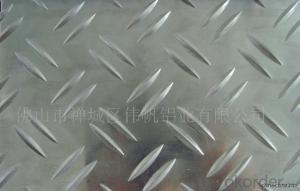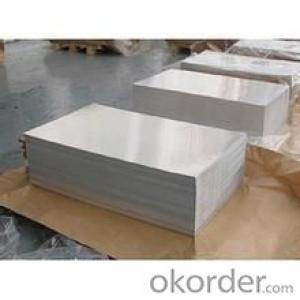Mill Finished Aluminum Strip for Engraving Sheets
- Loading Port:
- Shanghai
- Payment Terms:
- TT OR LC
- Min Order Qty:
- 5 m.t.
- Supply Capability:
- 600 m.t./month
OKorder Service Pledge
OKorder Financial Service
You Might Also Like
Specification
Temper: h14,h16,h18,h22,h24,h26,h32,o/f
Thickness: o.o3mm-3.0mm
Width: 30mm-1700mm
Coating: pe(polyester),pvdf,epoxy
Painting thickness: standard 16-25 mic, max 40 mic
Color: according to ral colors or customer's samples
Packaging & Delivery
| Packaging Details: | Coil ID :508MM Coil Weight : about 2.5 tons or as per customers requirement Packing ; In Export Sea worhty wooden pallets Eye to wall or Eye to Sky One container can be loaded about 20 mts |
| Delivery Detail: | within 25 days after receiving L/C deposit |
lloy | Si | Fe | Cu | Mn | Mg | Cr | Zn | Ti | Other | ||
Single | Total | ||||||||||
1050 | 0.25 | 0.4 | 0.05 | 0.05 | 0.05 | _ | 0.05 | 0.03 | 0.03 | _ | |
1060 | 0.25 | 0.35 | 0.05 | 0.03 | 0.03 | _ | 0.05 | 0.03 | 0.03 | _ | |
1070 | 0.2 | 0.25 | 0.04 | 0.03 | 0.03 | 0.04 | 0.03 | 0.03 | |||
1100 | Si+Fe:0.95 | 0.05~0.40 | 0.05 | _ | _ | 0.1 | _ | 0.05 | 0.15 | ||
1200 | Si+Fe:1.00 | 0.05 | 0.05 | _ | 0.1 | 0.05 | 0.05 | 0.15 | |||
3003 | 0.6 | 0.7 | 0.05~0.20 | 1.0~1.5 | _ | _ | 0.1 | _ | 0.05 | 0.15 | |
3004 | 0.3 | 0.7 | 0.25 | 1.0~1.5 | 0.8~1.3 | _ | 0.25 | _ | 0.05 | 0.15 | |
3005 | 0.6 | 0.7 | 0.3 | 1.0~1.5 | 0.20~0.6 | 0.1 | 0.25 | 0.1 | 0.05 | 0.15 | |
3105 | 0.6 | 0.7 | 0.3 | 0.30~0.8 | 0.20~0.8 | 0.2 | 0.4 | 0.1 | 0.05 | 0.15 | |
5005 | 0.3 | 0.7 | 0.2 | 0.2 | 0.50~1.1 | 0.1 | 0.25 | _ | 0.05 | 0.15 | |
5052 | 0.25 | 0.4 | 0.1 | 0.1 | 2.2~2.8 | 0.15~0.35 | 0.1 | _ | 0.05 | 0.15 | |
5083 | 0.4 | 0.4 | 0.1 | 0.40~1.0 | 4.0~4.9 | 0.05~0.25 | 0.25 | 0.15 | 0.05 | 0.15 | |
5086 | 0.4 | 0.5 | 0.1 | 0.20~0.7 | 3.5~4.5 | 0.05~0.25 | 0.25 | 0.15 | 0.05 | 0.15 | |
6061 | 0.4~0.8 | 0.7 | 0.15~0.40 | 0.15 | 0.80~1.20 | 0.04~0.35 | 0.25 | 0.15 | 0.05 | 0.15 | |
6063 | 0.2~0.6 | 0.35 | 0.1 | 0.1 | 0.45~0.90 | 0.1 | 0.1 | 0.1 | 0.05 | 0.15 | |
6082 | 0.7~1.3 | 0.5 | 0.1 | 0.4~1.0 | 0.6~1.2 | 0.25 | 0.2 | 0.1 | 0.05 | 0.15 | |
8011 | 0.5~0.9 | 0.6~1.0 | 0.1 | 0.2 | 0.05 | 0.05 | 0.1 | 0.08 | 0.05 | 0.15 | |


- Q: I have no idea, and I can't figure this out, and neither can my aunt and she's super smart. It's this project that's due on Monday, and if I can't get it turned in, then I get detention and a failing lab grade. The only information I have is it's $2.96 for a roll of aluminum, it contains 2.96 square meters, and it weighs .995 grams...
- say it's a trick question, because it there is no denotational value for a single aluminum atom :/
- Q: Which explains aluminum's resistance to corrosion? Any aluminum oxide that forms readily falls off the metal and exposes the corrosion-resistant metal. The aluminum oxide that forms adheres to the metal surface. The reduction half-reaction Al3+(aq) + 3e- ---gt; Al(s) occurs readily. The standard reduction potential for the Al3+/Al half-reaction is above the standard reduction potential for the O2/H2O half-reaction.
- The aluminum oxide that forms adheres to the metal surface explains aluminum's resistance to corrosion. Aluminum naturally forms a protective oxide film, which is stable in aqueous media when the pH is between about 4.0 and 8.5. The oxide film is naturally self-renewing and accidental abrasion or other mechanical damage of the surface film is rapidly repaired. The conditions that promote corrosion of aluminum and its alloys, therefore, must be those that continuously abrade the film mechanically or promote conditions that locally degrade the protective oxide film and minimize the availability of oxygen to rebuild it.
- Q: How do aluminum sheets perform in terms of thermal insulation?
- When it comes to thermal insulation, aluminum sheets are not efficient. Their high thermal conductivity allows heat to easily pass through them, making them ineffective in blocking or resisting heat transfer. As a result, their thermal insulation properties are poor. If your main concern is thermal insulation, it would be more appropriate to consider other materials like fiberglass, foam, or mineral wool as they would be better suited for the task.
- Q: I have a specific design I'd like to cut out of thin sheet metal (aluminum or tin) and I'm wondering how to make it more sturdy. The sheet metal is a bit flimsy. Can I strengthen it by heating it up (butane torch) and cooling it quickly?
- No. In fact, aluminum (and I believe tin) work harden when hammered - as do brass and copper and you heat to anneal and then you can cool fast or slow, still soft. Tin has a very low melting point and hitting it with a torch, especially if thin, will probably put a hole in it. The chances of you actually having tin sheet metal are very low - tin cans are zinc plated steel or some other coating. Steel does harden when quench, but heating tin or zinc coated metal is likely to damage the coating and perhaps give off noxious fumes - especially zinc.
- Q: Can aluminum sheets be used in marine environments?
- Indeed, aluminum sheets prove to be applicable in marine settings. Owing to its exceptional resistance to corrosion, aluminum stands as a prevalent choice for various marine purposes. The formation of a safeguarding oxide layer on its exterior inhibits further corrosion when exposed to saltwater or other corrosive substances commonly present in marine environments. Possessing both lightweight and robust properties, aluminum sheets become an optimal selection for a range of marine structures including boat hulls, decks, and superstructures. Furthermore, aluminum exhibits remarkable durability and an extended lifespan, thereby enhancing its appropriateness for marine applications.
- Q: What are the semi hard ones? What are the alloys? What are the anti rust ones, such as 3003505210606061, 7075?
- According to the content of alloy elements, aluminum plate can be divided into 8 series, namely 1***, 2***, 3***, 4***.5***.6***.7***.8***It can be divided into cold rolling and hot rolling according to different processing technologyAccording to the thickness difference can be divided into thin plate and medium plate,.GB/T3880-2006 standard in the thickness of 0.2 mm, called aluminum foilMore commonly used brands:Pure aluminum foil strip plate. 1060.. tensile plate, tube. Extrusion tube. Type. Great. Cold processing bar mainly for corrosion resistance in forming of high places, but not of high strength components, such as chemical equipment, marine equipment, railway tanker, conductive materials, instruments and meters the electrode material, and so on.
- Q: Are aluminum sheets resistant to impact and vibration?
- Aluminum sheets, in general, show resistance to impact and vibration. The notable feature of aluminum lies in its remarkable strength-to-weight ratio, rendering it a robust and lightweight substance. With commendable mechanical properties, including outstanding resistance to impact and vibration, aluminum sheets frequently find application in various sectors necessitating protection against such forces. Take, for instance, automotive parts, aircraft structures, and building facades. Furthermore, the addition of other elements to aluminum alloys can amplify its impact resistance and diminish vibrations. To sum up, aluminum sheets prove to be a dependable option in enduring the forces of impact and vibration.
- Q: Are aluminum sheets resistant to UV rays?
- Yes, aluminum sheets are generally resistant to UV rays.
- Q: Can aluminum sheets be used for solar panel applications?
- Yes, aluminum sheets can be used for solar panel applications. Aluminum is a lightweight and durable material that is commonly used for the frames and backings of solar panels. It offers good corrosion resistance and can efficiently dissipate heat, making it suitable for solar panel installations.
- Q: How do you clean aluminum sheets?
- To clean aluminum sheets, you can follow a few simple steps: 1. Start by removing any loose dirt or debris from the surface of the aluminum sheet. You can use a soft brush or cloth to gently sweep away any particles. 2. Prepare a cleaning solution by mixing a mild detergent or dish soap with warm water. Avoid using strong chemicals or abrasive cleaners as they can damage the aluminum. 3. Dip a soft cloth or sponge into the cleaning solution and gently scrub the aluminum sheet. Make sure to cover the entire surface, paying extra attention to any stains or spots. 4. If there are stubborn stains or marks on the aluminum, you can use a non-abrasive cleaner specifically designed for aluminum. Apply the cleaner to a soft cloth and rub gently on the affected area until the stain is removed. 5. Rinse the aluminum sheet thoroughly with clean water to remove any soap residue. This step is essential to prevent any build-up or streaks on the surface. 6. Dry the aluminum sheet completely using a soft towel or cloth. Make sure there is no moisture left as it can cause water spots or corrosion over time. 7. For added shine and protection, you can apply a thin layer of aluminum polish or wax. This will help to restore the luster and protect the aluminum from future tarnish or oxidation. It is important to note that the cleaning method may vary depending on the type of dirt or oxidation on the aluminum sheet. Always read and follow the manufacturer's instructions for specific cleaning recommendations.
Send your message to us
Mill Finished Aluminum Strip for Engraving Sheets
- Loading Port:
- Shanghai
- Payment Terms:
- TT OR LC
- Min Order Qty:
- 5 m.t.
- Supply Capability:
- 600 m.t./month
OKorder Service Pledge
OKorder Financial Service
Similar products
Hot products
Hot Searches
Related keywords


























